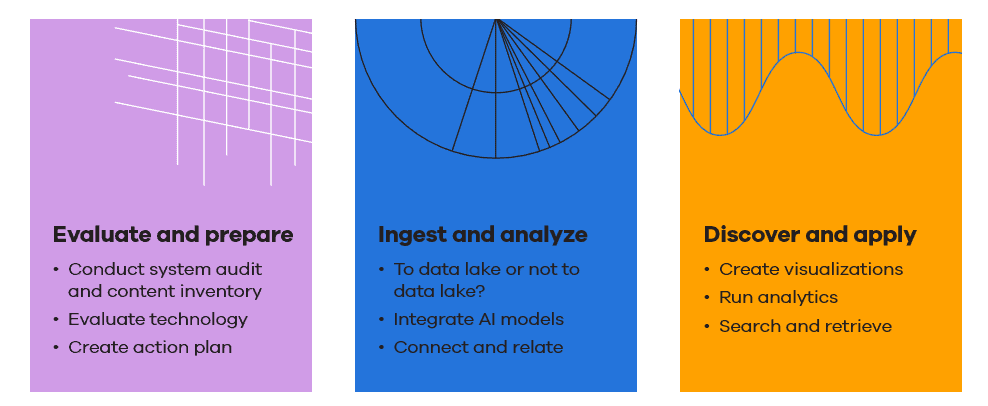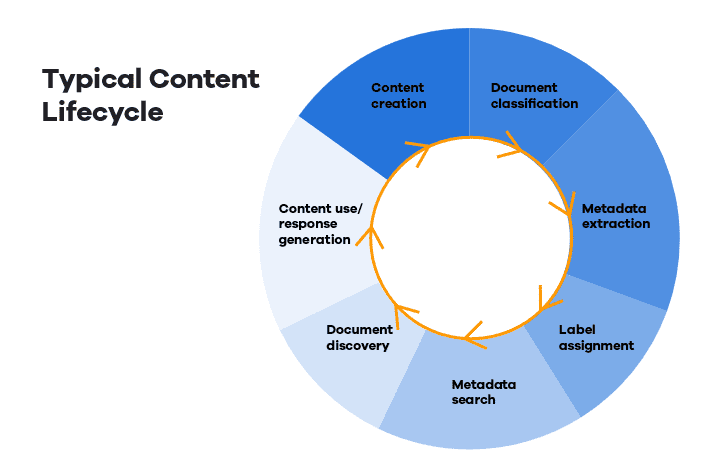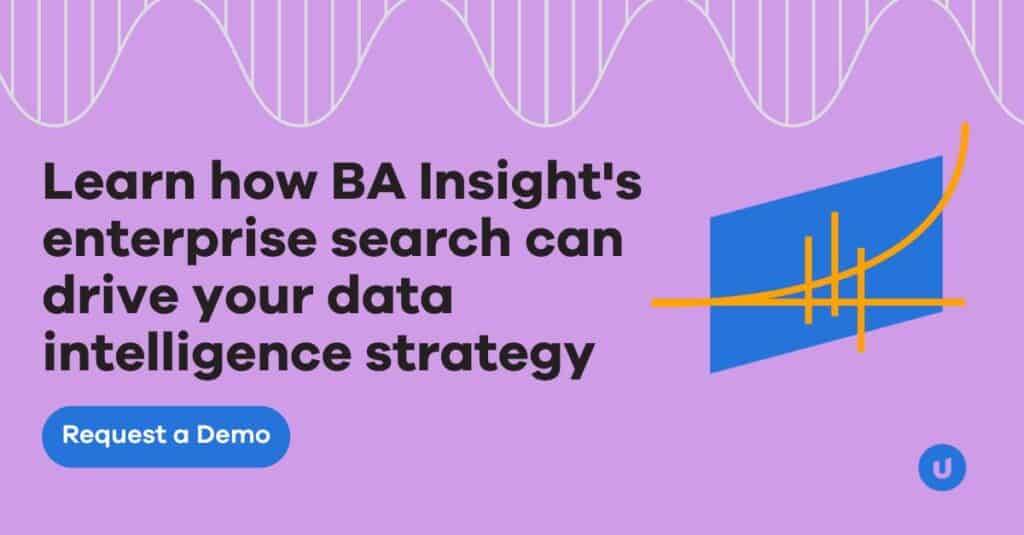Data Intelligence refers to the tools and methods organizations use to better understand the information they collect and store, to improve the quality of their goods or services.
Information and knowledge management is often underutilized because it is expensive and time-consuming to capture and deposit information into a manageable repository.
What is the price of NOT having a data intelligence strategy in place?
Employees spend as much as 19% of their day simply trying to locate information needed to do their jobs, or worse, duplicating efforts by recreating content in lost or misfiled documents. Understanding your organization’s content, where it is stored, and how to utilize it enables you to serve your customers more effectively.
A data intelligence strategy is beneficial because it provides a unified view of information across all key systems. Employees have a consolidated way to collaborate, review, and analyze the data to drive real results. Plus, a data intelligence strategy enables a future-focused approach to work by presenting the most accurate information at the right time, revealing better insights into current tasks as well as projects on the horizon.
Data intelligence also helps organizations make informed decisions by identifying patterns and insights that inform projections. Companies that understand where their data resides and how it is connected can predict potential trends, optimize methodologies, improve employee efficiency, lower overhead costs, and ensure the security of sensitive information within their systems.
Want to be more competitive in the market? Crafting a data intelligence methodology will help you:
- Deliver relevant, personalized, and actionable searches to reduce the time spent seeking information.
- Upgrade the quality and consistency of deliverables to provide a better customer experience.
- Enable permissioned access to specific results for sensitive data to mitigate risk and fraud.
- Support a unified view of information to boost utilization, realization, and proposal win rates.
- Optimize processes and procedures to improve and expand marketing and business development efforts.
- Inform decision-making to forecast future trends.
- Increase ROI while reducing costs.
- Enhance overall performance by improving workforce productivity and efficiency.
Ready to get moving? Here are three best practices to help your organization start envisioning the process to put an intelligent data strategy into place.

1. Evaluate what you have in preparation for your new data intelligence strategy.
First, take a step back to assess the data you have, figure out where it lives, and how to get to it. Is your data stored in the cloud, on-premises, in local databases, file shares, APIs, or a combination of several repositories? Create a comprehensive list of the systems and data in question. Different data types have different regulations governing them, such as GBLA, GPDR, HIPAA, Sarbanes Oxley, PCI DSS, and more.
Next, take a more technical look at your data systems and discern how they will be accessed, and which other systems need to interact with them. Many systems rely on CSV exports, especially for areas like Accounts Payable and Invoice Processing, where some tangential systems are performing various functions to communicate back to the ERP for payment.
As new Generative AI artificial intelligence technologies such as ChatGPT, Microsoft CoPilot, and Google Bard are hitting the market, it is no longer just about your internal data, but also about how the data is created. How can you support an investment in AI or machine learning? Are users currently manually entering data from one system to another? Consider an automation tool to transfer data. Apply this same line of thinking to all technologies. Is legacy software causing inefficiencies with secure practices? If your current processes are causing unnecessary frustration, there is an easier way to do things that can reduce errors and make users’ lives easier.
2. Ingest what you have, analyze its value, and visualize a simpler solution.
Few organizations can scale resources to support the rapid growth in data volume, data demands, or the ever-increasing complexities attached to data. With a global, often remote-first workforce, you must turn employee knowledge into organizational knowledge so anyone can access the same information as needed and by permissioned role.
The problem is that many organizations try to ingest every piece of content without understanding the problem they are trying to solve. Worse than that, they try to do this manually via groups of people around an organization, which does not scale. Ingestion and analysis are only part of an ongoing process. Automated processes deliver faster, more accurate results.
3. Discover and apply the right methodology for your organization.
By creating a data intelligence dashboard, your users can access a real-time visual snapshot that eliminates manual information gathering. The dashboard presents knowledge in a concise, easy-to-interpret format, so your team can make more informed decisions. Track analytics, examine KPIs, run reports, create graphs, and more. Compare and contrast statistics from different time periods across departments.

Thanks to natural language processing and conversational interfaces, chatbots, and virtual assistants can make it easier for any user to find information regardless of their technical abilities. A chat-based interface finds information without the user searching through pages of content. They can be programmed to tailor responses based on previous interactions, saving time and reducing errors.
Another useful method is implementing a decision support system (DSS), a computer-based tool that generates different scenarios based on the data to provide “what-if” analyses, simulations, and other modeling techniques to explore different possibilities and choose the best course of action.
Finally, a knowledge management program can help organizations to stay competitive by fostering innovation and continuous improvement. It can provide access to the latest research, trends, and industry developments to develop new products and services, identify new opportunities, and stay ahead of the competition.
Whatever method best fits your organization, enabling rapid content assembly empowers creators to quickly assemble new content from existing components instead of starting from scratch, so organizations can produce more with fewer resources.
Enterprise search can transform intelligent data.
The right data intelligence approach gives businesses a competitive advantage by identifying opportunities for growth and improving operations. It provides organizations with the ability to ask questions of their data, have confidence in the processes and procedures they have in place, and identify areas of weakness to mitigate the misuse of the data their customers entrust them with.
Applying the right data intelligence methodology for your firm will be much simpler after you have evaluated and analyzed your existing content. A well-defined data intelligence strategy can ultimately lead to increased revenue, happier employees, better customer experiences, and improved overall performance.
Upland BA Insight provides transformative, connected enterprise search software for all kinds of users. Watch our on-demand webinar, “How to Create a Data Intelligence Strategy” or book a demo to see the possibilities.




